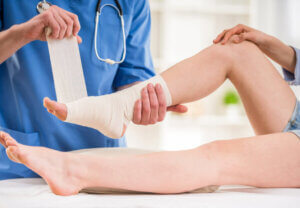Sports-Related Ankle Injuries

When a famous athlete suffers sports-related ankle injuries, people tend to find out very quickly, since news outlets often discuss the lengthy recovery time that these injuries demand. This is particularly the case when it comes to soccer and the major leagues. What should you know about these ailments?
The ankle is an anatomical structure that consists of the talus bone, tibia, fibula, ligaments, and tendons. Muscles cover the joint and protect it. In addition, they have fluid inside to lubricate movements.
The two most common sports-related ankle injuries are sprains and fractures. While the former affects the soft parts of the joint, the latter is typical of hard bone tissues.
Ankle sprains: sports-related ankle injuries
One of the most common sports-related ankle injuries is a sprain. This occurs because some of the ligaments that are responsible for stabilizing the joint overstretch.
In short, there are three ankle ligaments: the anterior talofibular ligament, the posterior talofibular ligament, and the calcaneofibular ligament. The former has the highest prevalence of injuries.
Similarly, as a publication in the Journal of the Industrial University of Santander states, ankle sprains are classified into three groups according to their severity:
- Grade 1: a mild sprain and the ligaments are stretched slightly. It means that the soft tissues have been stretched but didn’t break. Sometimes, it can go unnoticed by an athlete. In addition, a doctor may have a hard time diagnosing it with medical imaging techniques.
- Grade 2: a moderate sprain or incomplete ligament tear. Its symptoms are more evident. In fact, it causes swelling, pain, functional impotence, and even some bruising.
- Grade 3: the most severe, as a total ligament tear occurs. The joint is disabled, meaning that you can’t move it. The pain is intense and disabling.

Treatment of ankle sprains
The treatment of this sports-related injury will depend on the grade, which the treating physician will determine. A conservative approach that consists of bandaging, cold therapy, and anti-inflammatory drugs is convenient for the first two grades.
Rest is always necessary to allow time for the fibers to regain their normal elasticity and repair damaged fibers. Bandaging can help stabilize the joint, just as elevating limbs, to favor fluid drainage from the joint to the lymphatic and venous system.
For a grade three ankle sprain, a specific tendon and ligament repair surgery is required, which needs to be followed by physical therapy. Rehabilitation is essential and determines how fast an athlete can resume their sports activities.
Sports-related ankle injuries: fractures
Ankle fractures can happen above or below the joint. Although those that happen above the joint don’t impact the athlete’s subsequent recovery as much, they’re still serious.
The most common cause of this sports-related ankle injury is trauma in contact sports. On rare occasions, it occurs due to missteps, tripping over, or unstable terrains. In fact, these situations most often lead to sprains than fractures.
A fracture causes immediate pain and, usually, bruising with crepitus. Crepitus is grating, crackling, or popping sounds and sensations at the site of the injury. If it’s very noticeable, air may have become trapped in the fatty tissue, with the subsequent risk of embolism.
When a fracture occurs, you can see leg and ankle deformity. If one of the bones involved breaks through the skin, it’s an open fracture. As such, the likelihood of infection increases.
Treatment of ankle fractures
Not all ankle fractures can be treated in the same way. This will depend on the severity and if the neighboring structures were compromised, as well as the athlete’s age and physical condition.
Casts and physical therapy are options for minor fractures. Firstly, the fracture must be immobilized for two months. Then, a medical professional must place an artificial heel in the cast so the patient can progressively start walking again.

When it comes to surgery, osteosynthesis implants are used. In other words, orthopedic plates and nails that a traumatologist places as internal fixations. In any case, after being discharged from the hospital, the patient has to continue wearing a cast to give the bone time to heal.
Physical therapy will vary in duration and technique, depending on the case. When it comes to professional athletes, this is an unavoidable and essential step so they can resume intense activities and avoid collateral injuries, such as chronic ankle instability.
Caring for sports-related ankle injuries
Every athlete should protect themselves from possible sports-related ankle injuries, especially if they play soccer or practice jogging. In addition, if you suspect that you may have this type of injury, prompt treatment will prevent future complications.
Traumatologists are trained to detect and diagnose the severity of ankle sprains and fractures. Using medical imaging techniques, they’ll know what’s the best treatment option for you and how to continue rehabilitation so you can resume playing your favorite sport.
When a famous athlete suffers sports-related ankle injuries, people tend to find out very quickly, since news outlets often discuss the lengthy recovery time that these injuries demand. This is particularly the case when it comes to soccer and the major leagues. What should you know about these ailments?
The ankle is an anatomical structure that consists of the talus bone, tibia, fibula, ligaments, and tendons. Muscles cover the joint and protect it. In addition, they have fluid inside to lubricate movements.
The two most common sports-related ankle injuries are sprains and fractures. While the former affects the soft parts of the joint, the latter is typical of hard bone tissues.
Ankle sprains: sports-related ankle injuries
One of the most common sports-related ankle injuries is a sprain. This occurs because some of the ligaments that are responsible for stabilizing the joint overstretch.
In short, there are three ankle ligaments: the anterior talofibular ligament, the posterior talofibular ligament, and the calcaneofibular ligament. The former has the highest prevalence of injuries.
Similarly, as a publication in the Journal of the Industrial University of Santander states, ankle sprains are classified into three groups according to their severity:
- Grade 1: a mild sprain and the ligaments are stretched slightly. It means that the soft tissues have been stretched but didn’t break. Sometimes, it can go unnoticed by an athlete. In addition, a doctor may have a hard time diagnosing it with medical imaging techniques.
- Grade 2: a moderate sprain or incomplete ligament tear. Its symptoms are more evident. In fact, it causes swelling, pain, functional impotence, and even some bruising.
- Grade 3: the most severe, as a total ligament tear occurs. The joint is disabled, meaning that you can’t move it. The pain is intense and disabling.

Treatment of ankle sprains
The treatment of this sports-related injury will depend on the grade, which the treating physician will determine. A conservative approach that consists of bandaging, cold therapy, and anti-inflammatory drugs is convenient for the first two grades.
Rest is always necessary to allow time for the fibers to regain their normal elasticity and repair damaged fibers. Bandaging can help stabilize the joint, just as elevating limbs, to favor fluid drainage from the joint to the lymphatic and venous system.
For a grade three ankle sprain, a specific tendon and ligament repair surgery is required, which needs to be followed by physical therapy. Rehabilitation is essential and determines how fast an athlete can resume their sports activities.
Sports-related ankle injuries: fractures
Ankle fractures can happen above or below the joint. Although those that happen above the joint don’t impact the athlete’s subsequent recovery as much, they’re still serious.
The most common cause of this sports-related ankle injury is trauma in contact sports. On rare occasions, it occurs due to missteps, tripping over, or unstable terrains. In fact, these situations most often lead to sprains than fractures.
A fracture causes immediate pain and, usually, bruising with crepitus. Crepitus is grating, crackling, or popping sounds and sensations at the site of the injury. If it’s very noticeable, air may have become trapped in the fatty tissue, with the subsequent risk of embolism.
When a fracture occurs, you can see leg and ankle deformity. If one of the bones involved breaks through the skin, it’s an open fracture. As such, the likelihood of infection increases.
Treatment of ankle fractures
Not all ankle fractures can be treated in the same way. This will depend on the severity and if the neighboring structures were compromised, as well as the athlete’s age and physical condition.
Casts and physical therapy are options for minor fractures. Firstly, the fracture must be immobilized for two months. Then, a medical professional must place an artificial heel in the cast so the patient can progressively start walking again.

When it comes to surgery, osteosynthesis implants are used. In other words, orthopedic plates and nails that a traumatologist places as internal fixations. In any case, after being discharged from the hospital, the patient has to continue wearing a cast to give the bone time to heal.
Physical therapy will vary in duration and technique, depending on the case. When it comes to professional athletes, this is an unavoidable and essential step so they can resume intense activities and avoid collateral injuries, such as chronic ankle instability.
Caring for sports-related ankle injuries
Every athlete should protect themselves from possible sports-related ankle injuries, especially if they play soccer or practice jogging. In addition, if you suspect that you may have this type of injury, prompt treatment will prevent future complications.
Traumatologists are trained to detect and diagnose the severity of ankle sprains and fractures. Using medical imaging techniques, they’ll know what’s the best treatment option for you and how to continue rehabilitation so you can resume playing your favorite sport.
All cited sources were thoroughly reviewed by our team to ensure their quality, reliability, currency, and validity. The bibliography of this article was considered reliable and of academic or scientific accuracy.
- Cardozo, Diego Fernando Rincón, Natalia Sauza Rodriguez, and Paula Andrea Rincón Cardozo. Abordaje del esguince de tobillo para el médico general. Revista Salud UIS 47.1 (2015).
- Rojas, José Emigdio Alberto Pérez, et al. Guía clínica para la atención del paciente con esguince de tobillo. Revista Médica del Instituto Mexicano del Seguro Social 42.5 (2004): 437-444.
- Golanó Álvarez, Pau, et al. Anatomía de los ligamentos del tobillo (Comunicación oficial 1 (SECOT, Madrid, octubre 2004)). Revista de Ortopedia y Traumatología, 2004, vol. 48, num. Supl. 3, p. 35-44 (2004).
- Sánchez, JO Sous, et al. Fracturas de tobillo en deportistas. Estudio epidemiológico. Revista Internacional de Medicina y Ciencias de la Actividad Física y del Deporte/International Journal of Medicine and Science of Physical Activity and Sport 13.50 (2013): 257-278.
- Díaz, José Fernando Jiménez. Diagnóstico ecográfico de las lesiones de tobillo en el jugador de baloncesto. Novedades en medicina y traumatología del deporte: baloncesto. Quaderna Toledo, 2006. 129-138.
- Urrialde, JA Martín, S. Patiño Núñez, and A. Bar del Olmo. Inestabilidad crónica de tobillo en deportistas. Prevención y actuación fisioterápica. Revista Iberoamericana de Fisioterapia y Kinesiología 9.2 (2006): 57-67.
This text is provided for informational purposes only and does not replace consultation with a professional. If in doubt, consult your specialist.








